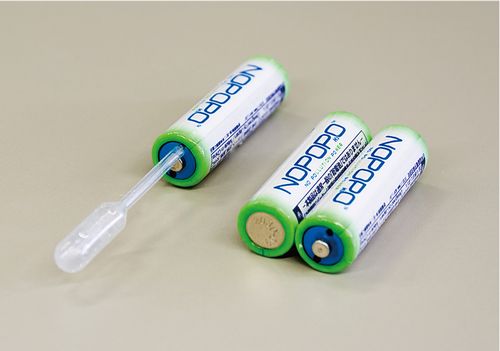 Digio2 Water Cell NOPOPO (TM), which generates electricity when water is poured into it. The cell can be easily stored for use during disasters and emergencies.
Digio2 Water Cell NOPOPO (TM), which generates electricity when water is poured into it. The cell can be easily stored for use during disasters and emergencies.The water-powered cell, the size of an AA battery, is activated when water is put into an opening using an attached syringe. An ordinary cell battery discharges a slight amount of electricity even when not in use, causing a gradual decease in power capacity over an extended period of time. The water-activated cell, in contrast, can be stored for about 20 years unopened because the cell works only when water is poured into it, causing a chemical reaction.
One of these batteries can, for example, provide enough electricity to light a light-emitting diode (LED) for about five hours. The number of uses depends on the amount of electricity required by the device used with the cell. When its power weakens, the cell can be recharged several times simply by adding more water.
Because 100 units weigh only 1.5 kilograms -- lighter than 100 ordinary batteries weighing 2.3 kilograms -- it is ideal for storage, such as at public facilities. In addition, it contains no toxic substances such as mercury, hexavalent chromium, or cadmium, permitting safe disposal after use...